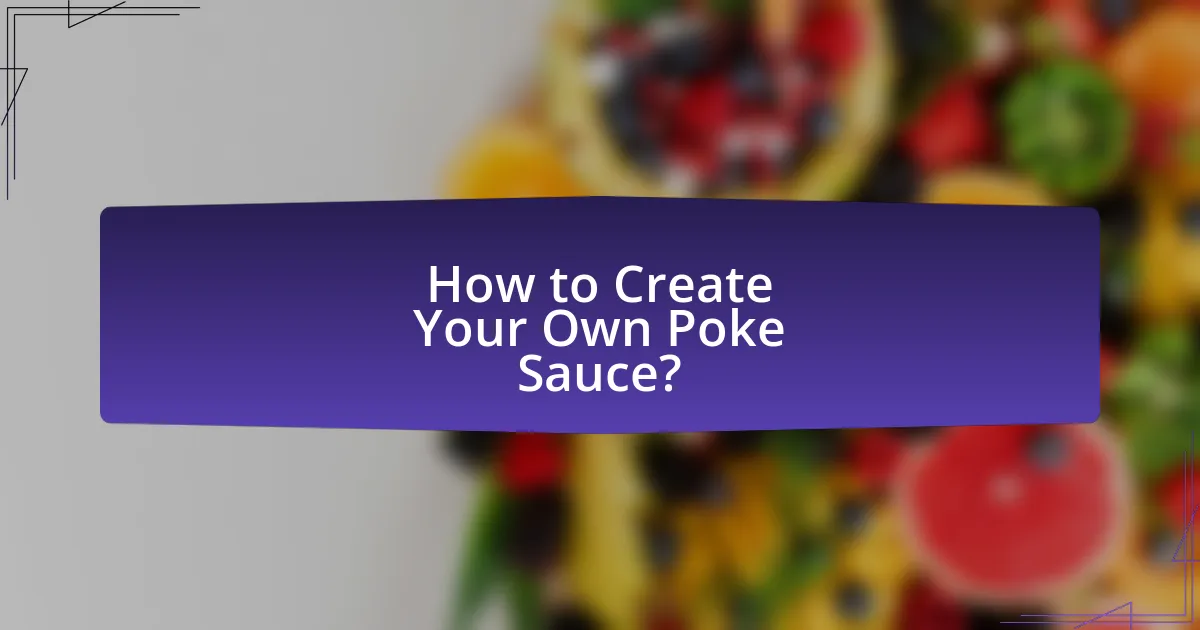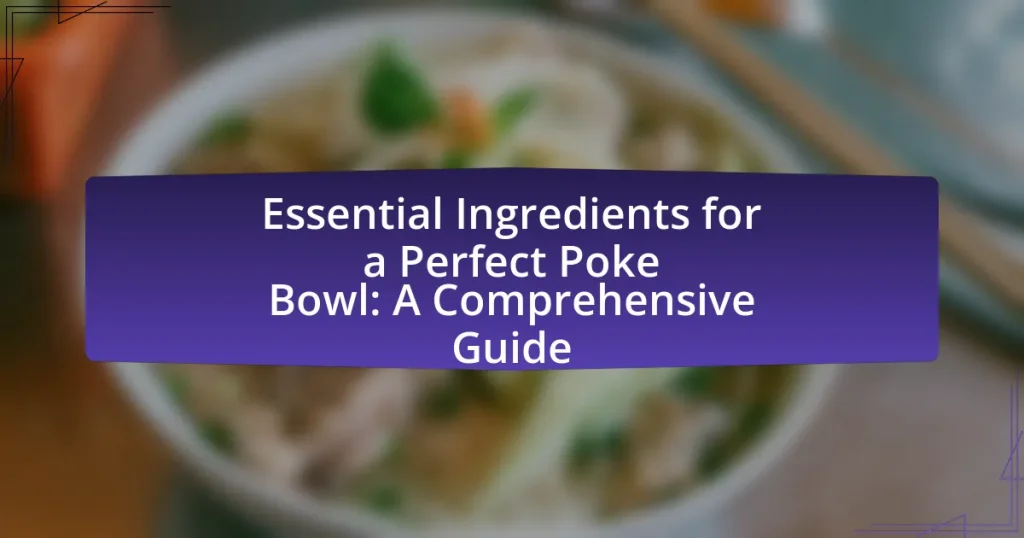Homemade poke sauces are essential condiments designed to enhance the flavor of poke bowls, a traditional Hawaiian dish featuring raw fish. These sauces typically consist of high-quality ingredients such as soy sauce, sesame oil, and rice vinegar, allowing for customization with additional elements like citrus and spices. The article explores the differences between homemade and store-bought sauces, key flavor profiles, and techniques for creating and perfecting these sauces. It also provides guidance on troubleshooting common issues, storage practices, and serving suggestions to maximize the culinary experience of poke dishes.

What are Homemade Poke Sauces?
Homemade poke sauces are flavorful condiments specifically crafted for enhancing poke bowls, a traditional Hawaiian dish featuring diced raw fish. These sauces typically combine ingredients such as soy sauce, sesame oil, and various seasonings to create a savory and umami-rich profile. The versatility of homemade poke sauces allows for customization, enabling the addition of elements like citrus, chili, or ginger to suit individual tastes. The use of fresh, high-quality ingredients in these sauces ensures a vibrant flavor that complements the freshness of the fish and other poke bowl components.
How do Homemade Poke Sauces differ from store-bought options?
Homemade poke sauces differ from store-bought options primarily in their ingredient quality and customization potential. Homemade sauces often utilize fresh, high-quality ingredients, allowing for a more vibrant flavor profile and the ability to adjust seasonings according to personal taste. In contrast, store-bought sauces frequently contain preservatives, artificial flavors, and added sugars, which can compromise the freshness and authenticity of the taste. Additionally, homemade versions can be tailored to dietary preferences, such as low-sodium or gluten-free, while store-bought options may lack such flexibility.
What ingredients are typically used in Homemade Poke Sauces?
Homemade poke sauces typically include soy sauce, sesame oil, and rice vinegar as the primary ingredients. These components create a balanced flavor profile, with soy sauce providing umami, sesame oil adding nuttiness, and rice vinegar contributing acidity. Additional ingredients often include green onions, garlic, ginger, and chili flakes, which enhance the sauce’s complexity and depth. The combination of these ingredients is essential for achieving the authentic taste associated with poke dishes.
Why is freshness important in Homemade Poke Sauces?
Freshness is crucial in homemade poke sauces because it directly impacts flavor, aroma, and overall quality. Fresh ingredients, such as herbs, citrus, and fish, enhance the taste profile and ensure that the sauce complements the poke bowl effectively. For instance, using freshly squeezed citrus juice provides a vibrant acidity that balances the richness of the fish, while fresh herbs contribute aromatic notes that elevate the dish. Additionally, fresh ingredients are more nutritious, offering better health benefits compared to older, less vibrant components. Therefore, the use of fresh ingredients in homemade poke sauces is essential for achieving the best culinary experience.
What are the key flavor profiles of Homemade Poke Sauces?
The key flavor profiles of homemade poke sauces include umami, sweetness, saltiness, and acidity. Umami is primarily derived from ingredients like soy sauce or miso, which provide a savory depth. Sweetness often comes from elements such as honey or sugar, balancing the saltiness from soy sauce. Saltiness is a crucial component, enhancing the overall flavor, while acidity is introduced through ingredients like rice vinegar or citrus juice, adding brightness and freshness to the sauce. These profiles work together to create a well-rounded and flavorful poke sauce that complements the freshness of the fish.
How do different ingredients influence the flavor of Poke Sauces?
Different ingredients significantly influence the flavor of poke sauces by contributing unique taste profiles and enhancing overall complexity. For instance, soy sauce provides a salty umami base, while sesame oil adds a nutty richness. Citrus juices, such as lime or yuzu, introduce acidity and brightness, balancing the savory elements. Additionally, ingredients like ginger and garlic impart spiciness and depth, while sweeteners like honey or sugar can round out flavors, creating a harmonious blend. The combination of these ingredients allows for a wide range of flavor variations, catering to individual preferences and regional styles.
What role do spices and seasonings play in enhancing flavors?
Spices and seasonings play a crucial role in enhancing flavors by adding depth, complexity, and balance to dishes. They can transform a bland meal into a vibrant culinary experience by introducing various taste profiles such as sweet, salty, sour, bitter, and umami. For example, spices like cumin and coriander can provide warmth and earthiness, while seasonings like salt and pepper enhance the natural flavors of ingredients. Studies have shown that the use of spices can also stimulate appetite and improve overall satisfaction with meals, as evidenced by research published in the Journal of Food Science, which highlights how specific spices can elevate sensory perceptions of food.

How to Create Your Own Poke Sauce?
To create your own poke sauce, combine soy sauce, sesame oil, and rice vinegar in a bowl, adjusting the ratios to taste. This mixture serves as a foundational base for poke sauce, commonly used in Hawaiian cuisine. For added flavor, incorporate ingredients like minced garlic, grated ginger, and a touch of honey or sriracha for sweetness or heat, respectively. These components enhance the sauce’s complexity, making it suitable for various poke bowls.
What are the basic steps to making a Homemade Poke Sauce?
To make a homemade poke sauce, combine soy sauce, sesame oil, and rice vinegar in a bowl. Start by measuring equal parts soy sauce and sesame oil, then add a splash of rice vinegar for acidity. Mix these ingredients thoroughly to create a balanced flavor profile. Optionally, you can include ingredients like minced garlic, grated ginger, or chili flakes for added depth and heat. This method is effective as it utilizes common ingredients that enhance the umami taste, which is essential in poke sauces.
How do you prepare the base for your Poke Sauce?
To prepare the base for poke sauce, combine soy sauce, sesame oil, and rice vinegar in a bowl. This mixture creates a balanced flavor profile essential for poke sauce. The soy sauce provides umami, the sesame oil adds richness, and the rice vinegar contributes acidity, enhancing the overall taste.
What techniques can enhance the flavor during preparation?
To enhance flavor during preparation, techniques such as marinating, toasting spices, and balancing acidity can be employed. Marinating proteins in a mixture of soy sauce, citrus juice, and aromatics allows the flavors to penetrate deeply, resulting in a more flavorful dish. Toasting spices before adding them to a sauce releases essential oils, intensifying their flavor profile. Additionally, balancing acidity with ingredients like vinegar or citrus not only brightens the overall taste but also enhances the perception of other flavors, creating a more complex and satisfying sauce. These techniques are widely recognized in culinary practices for their effectiveness in flavor enhancement.
What variations can you explore in your Poke Sauce recipes?
You can explore variations in your Poke Sauce recipes by adjusting the base ingredients, such as using soy sauce, tamari, or coconut aminos for different flavor profiles. Additionally, incorporating elements like sesame oil, rice vinegar, or citrus juices can enhance the taste. You can also experiment with spice levels by adding sriracha, wasabi, or chili flakes. Furthermore, including sweeteners like honey or agave syrup can balance the flavors. Each of these variations allows for customization based on personal preferences and dietary needs, making the sauce versatile for different poke bowl combinations.
How can you customize your Poke Sauce for different tastes?
You can customize your Poke Sauce for different tastes by adjusting the balance of soy sauce, sesame oil, and other flavoring ingredients. For a sweeter sauce, increase the amount of honey or sugar; for a spicier kick, add more chili paste or sriracha. Additionally, incorporating citrus juices like lime or yuzu can enhance freshness, while adding garlic or ginger can deepen the flavor profile. These adjustments allow for a versatile sauce that caters to individual preferences, ensuring a personalized Poke experience.
What are some popular regional variations of Poke Sauces?
Popular regional variations of poke sauces include shoyu sauce, which is a soy sauce-based dressing commonly used in Hawaii, and spicy mayo, a blend of mayonnaise and sriracha that adds heat and creaminess. Additionally, sesame oil-based sauces are popular in some regions, providing a nutty flavor, while miso-based sauces offer a rich, umami taste. These variations reflect local ingredients and culinary preferences, enhancing the poke experience.

What Tips Can Help You Perfect Your Poke Sauces?
To perfect your poke sauces, focus on balancing flavors, using fresh ingredients, and experimenting with ratios. A well-balanced poke sauce typically combines soy sauce, sesame oil, and a touch of sweetness, such as honey or sugar, to create depth. Fresh ingredients like scallions, ginger, and chili add brightness and complexity. Experimenting with ratios allows for customization; for instance, a common ratio is 3 parts soy sauce to 1 part sesame oil, adjusting sweetness to taste. This approach is supported by culinary practices that emphasize flavor balance in Asian cuisine, ensuring a harmonious sauce that enhances the poke experience.
How can you troubleshoot common issues in Homemade Poke Sauces?
To troubleshoot common issues in homemade poke sauces, first identify the specific problem, such as imbalance in flavor, texture, or freshness. For flavor imbalance, adjust the ingredients; for instance, if the sauce is too salty, add more acid like lime juice or vinegar to balance it. If the texture is too thick, incorporate a small amount of water or additional oil to achieve the desired consistency. Freshness can be improved by using high-quality, fresh ingredients and ensuring proper storage. These methods are effective as they directly address the common issues faced in poke sauce preparation, ensuring a well-balanced and enjoyable flavor profile.
What should you do if your sauce is too salty or bland?
If your sauce is too salty, you can dilute it by adding more liquid, such as water, broth, or a complementary sauce, which will help balance the saltiness. If the sauce is too bland, enhance its flavor by incorporating ingredients like herbs, spices, or acidic components such as vinegar or citrus juice. These adjustments are effective because they modify the overall flavor profile, making the sauce more palatable.
How can you adjust the consistency of your Poke Sauce?
To adjust the consistency of your Poke Sauce, you can modify the amount of liquid ingredients such as soy sauce, vinegar, or citrus juice. Increasing the quantity of these liquids will create a thinner sauce, while reducing them will result in a thicker consistency. For example, if you find your sauce too thick, adding a tablespoon of water or additional soy sauce can help achieve the desired texture. Conversely, if the sauce is too thin, incorporating a small amount of cornstarch mixed with water can thicken it effectively.
What are some best practices for storing and serving Homemade Poke Sauces?
Homemade poke sauces should be stored in airtight containers in the refrigerator to maintain freshness and prevent contamination. It is recommended to use glass or BPA-free plastic containers, as these materials do not react with the ingredients. Homemade poke sauces can typically last for up to one week when stored properly. When serving, it is best to allow the sauce to come to room temperature for enhanced flavor, and to serve it alongside poke bowls or as a marinade for seafood. This practice ensures optimal taste and safety, as sauces made with fresh ingredients are best enjoyed when consumed within a short timeframe.
How long can you store Homemade Poke Sauces without losing quality?
Homemade poke sauces can be stored for up to one week in the refrigerator without losing quality. This timeframe is supported by the fact that the ingredients typically used, such as soy sauce, sesame oil, and fresh aromatics, maintain their flavor and safety for about seven days when kept in an airtight container. Beyond this period, the quality may decline due to potential spoilage or flavor degradation.
What are the best serving suggestions for your Poke Sauces?
The best serving suggestions for poke sauces include drizzling them over fresh poke bowls, marinating seafood, and using them as dipping sauces for vegetables or sushi. Poke bowls typically consist of a base like rice or salad topped with fresh fish, vegetables, and garnishes, where the poke sauce enhances the overall flavor profile. Marinating seafood in poke sauce for at least 30 minutes allows the flavors to penetrate, resulting in a more flavorful dish. Additionally, using poke sauces as dipping sauces complements raw vegetables or sushi, providing a zesty kick. These methods maximize the flavor and versatility of poke sauces in various culinary applications.



